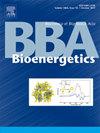Conformational dynamics of a histidine molecular switch in a cation/proton antiporter
IF 2.7
2区 生物学
Q2 BIOCHEMISTRY & MOLECULAR BIOLOGY
引用次数: 0
Abstract
Multisubunit Mrp (multiple resistance and pH adaptation) type sodium proton antiporters are indispensable for the growth of alkali and salt tolerant bacteria and archaea. They share sequence and structural similarity with the membrane domain of respiratory complex I, a key mitochondrial enzyme. The molecular mechanism of complex I and Mrp antiporters has remained largely unknown and is the subject of intense debate. Here, by combining site-directed mutagenesis with large-scale molecular dynamics simulations, we explore the conformational dynamics of a key histidine residue in the MrpA subunit of the antiporter. We show that point mutations perturbing the conformational mobility of the histidine sidechain directly affect the transport activity of the antiporter. We identify that protonation state variations in conserved lysine residues around the histidine drive hydrogen bonding rearrangements and hydration changes coupled to sidechain and backbone conformational dynamics. Finally, we develop detailed and testable mechanistic models of proton transfer in Mrp antiporter and complex I, in which the histidine switch functions as a unique gating element.
阳离子/质子反转运体中组氨酸分子开关的构象动力学
多亚基Mrp (multiple resistance and pH adaptation)型钠质子反转运蛋白是耐碱耐盐细菌和古细菌生长所必需的。它们与呼吸复合体I(一种关键的线粒体酶)的膜结构域具有序列和结构相似性。复合体I和Mrp反转运蛋白的分子机制在很大程度上仍然是未知的,是激烈争论的主题。在这里,通过结合位点定向突变和大规模分子动力学模拟,我们探索了反转运蛋白MrpA亚基中一个关键组氨酸残基的构象动力学。我们发现扰乱组氨酸侧链构象迁移的点突变直接影响反转运蛋白的转运活性。我们发现,组氨酸周围保守赖氨酸残基的质子化状态变化驱动氢键重排和水合作用变化,以及侧链和主链构象动力学。最后,我们建立了Mrp反转运体和复合体I中质子转移的详细和可测试的机制模型,其中组氨酸开关作为独特的门控元件起作用。
本文章由计算机程序翻译,如有差异,请以英文原文为准。
求助全文
约1分钟内获得全文
求助全文
来源期刊

Biochimica et Biophysica Acta-Bioenergetics
生物-生化与分子生物学
CiteScore
9.50
自引率
7.00%
发文量
363
审稿时长
92 days
期刊介绍:
BBA Bioenergetics covers the area of biological membranes involved in energy transfer and conversion. In particular, it focuses on the structures obtained by X-ray crystallography and other approaches, and molecular mechanisms of the components of photosynthesis, mitochondrial and bacterial respiration, oxidative phosphorylation, motility and transport. It spans applications of structural biology, molecular modeling, spectroscopy and biophysics in these systems, through bioenergetic aspects of mitochondrial biology including biomedicine aspects of energy metabolism in mitochondrial disorders, neurodegenerative diseases like Parkinson''s and Alzheimer''s, aging, diabetes and even cancer.
 求助内容:
求助内容: 应助结果提醒方式:
应助结果提醒方式:


